As a result of the autonomy granted to each business unit, the headquarters lost its ability to fully manage processes across the organization. As budgets tightened, the headquarters realized that the dissimilar cost center structures prevented proper cost comparisons across business units which impeded leadership’s ability to identify best practices and led to inconsistent financial metrics. WP&C worked with the headquarters to gain control of these processes. This was accomplished by aligning the business units to the same cost center structure with clear categorization of the activities that belong within each cost center.
Working with the finance leads of each business unit along with members of the leadership team, WP&C established the new cost center structure:
- First, an assessment was completed that documented the current structures for each business unit.WP&C evaluated the rationale behind the structure as well as identified unique activities for each business unit that needed to be captured.
- Once leadership had a clear understanding of the current cost structures that were in place, WP&C formulated a preliminary cost center structure that included common elements present for all business units as well as those unique to individual business units.
- In order to facilitate organization-wide buy-in to the new processes, WP&C conducted workshops with finance leads from each business unit to review, modify, and align on the path forward. WP&C used a preliminary structure as a starting point for the discussions and modified the design based on feedback from the participants. These workshops allowed each business unit to have their voice heard and contribute to the final design.
- WP&C worked directly with the client to implement the new processes across the enterprise.
As a result of the workshop findings, WP&C partnered with the client to develop a comprehensive plan that would limit financial and organizational disruption to the business units while still moving forward with implementation:
- Creation of a standardized cost center structure that included explicit definitions of activities included within each cost center with structure and definitions agreed upon by all stakeholders
- Identification of allowable exceptions from the standard to accommodate the unique restrictions and requirements of each business unit
- Leadership and business unit agreement on the implementation plan including milestones, owners, and additional items to be addressed
- Development of tools and documentation that would support implementation and enable the headquarters to sustainably manage the initiative following the conclusion of WP&C support

WP&C gained alignment from all stakeholders on the new cost center design to include the headquarters and business units. Armed with an executable and sustainable implementation plan, in less than six months the new structure reduced the number of active cost centers for business units from hundreds down to only a few dozen, eliminated the need for leadership to conduct time-consuming individualized costs analysis, and allowed for actionable insights to be consistently captured.
The standardized cost center structure provided the foundation needed to capture additional benefits within financial processes. In particular, with the new cost center structure in place, budget generation and labor rate calculations were quickly identified as follow-on initiatives that would be standardized for additional gains.



